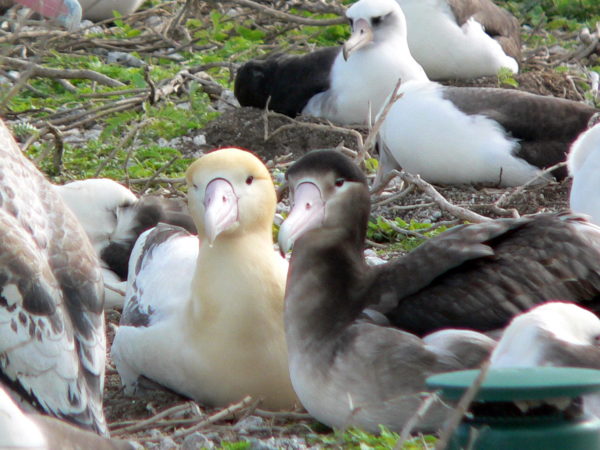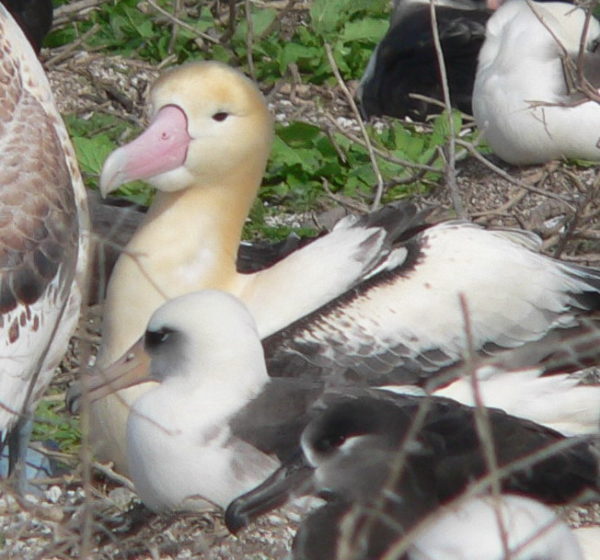Published in the Ocean Watch column, Honolulu Star-Advertiser © Susan Scott
Friday, January 18, 2008
MIDWAY ATOLL » On remote atolls where biologists, volunteers and wildlife live in close quarters, it’s common for romance to bloom. Here at Midway it’s encouraged.
People have been introducing singles, throwing parties and then spying on couples to see what they’re doing. Make a commitment, everyone urges silently as we peek at them cuddling. And then, please, please raise some kids.
The singles are short-tailed albatrosses, also called golden goonies, one of the three albatross species native to the North Pacific. Midway currently has three of these remarkable seabirds searching the atoll for mates.
Goldens are easy to spot among the millions of birds here because they’re taller, heavier and have a wider wingspan (7 feet) than Laysans and black-foots.
They also have stunning gold heads and necks that glisten in the sun, and bubble gum pink bills tipped in baby blue. To see one is to fall in love.
In 1949, short-tails were thought to be extinct, all killed for feathers. Albatrosses, though, are offshore marine animals and that saved them. As the last adult short-tail was clubbed to death while it sat on its egg, 30 to 50 juveniles soared over the open ocean, hunting for fish and squid.
This oceanic stage of an albatross’s life can last for four or five years. Then, as the bird begins to mature, it comes to land looking for members of its own kind. Choosing a mate can take years, and the choice will be for life.
The one mature golden goony here now has been coming to Midway Atoll during breeding season for 10 years with no luck in finding that special someone. To help attract a partner for this handsome bachelor, biologists put out 36 decoys and a continuous recording of their mating songs.
When a juvenile (obvious by its lack of gold head) arrived a few years ago, hope soared. But the birds, on two different islands, didn’t notice one another. Playing matchmaker, biologists captured the juvenile and released it near the adult.

Adult & juvenile short-tailed albatrosses
No sparks flew but the juvenile did. The next day it was back where it started.
Such extraordinary efforts are justified because most of the 2,350 short-tails in the world nest on Torishima, an island 370 miles south of Japan. Since Torishima has an active volcano, breeding colonies in other locations are crucial to the species’ survival.
Midway apparently looks good to some of the birds. While we volunteers were counting Laysans and black-foots on Sand Island a few weeks ago, two counters spotted a second juvenile short-tail sitting next to the first. Word spread fast, and soon people were bicycling to the site to see this notable pair of pioneers.
Last week the birds gave us even more to cheer about. While working on Eastern Island, biologist John Klavitter and I visited decoy town and saw one of the juvenile short-tails cuddled next to the adult. If these two mate, it could be the beginning of a breeding population of these fabulous albatrosses on Midway.
Later, when biologists saw the couple singing and dancing, a visitor here suggested the pair’s song might be “Love the One You’re With.”
We hope.
You can see researcher Hiroshi Hasagawa’s photos of short-tails at www.mnc.toho-u.ac.jp and two of Midway’s short-tails at www.fws.gov.

Hawaii’s three natives (from top): Short-tailed Albatross, Laysan Albatross, Black Footed Albatross